Submitted by chandra on Wed, 2011-03-16 18:14
People seem to be fascinated with the concept of sound in space. This was just underscored for us when we saw this great TED talk by physicist Janna Levin.
We have some personal experience with the public’s interest in the topic. Way back in 2003, we did a story on the black hole at the center of the Perseus Cluster. The energy generated by the giant black hole was responsible for sound waves propagating through the intercluster gas. (If you're curious, the black hole was bleating out a B flat some 52 octaves below middle C.)
Submitted by chandra on Mon, 2011-03-14 14:08
OK, you probably couldn’t with Albert Einstein (who most likely wouldn't have appreciated the Paul Simon reference.) If Einstein had lived, he would have been celebrating his 132nd birthday today. Alas, he sadly died back in 1955, but, as we all know, he managed to squeeze in quite a bit during those years.
Submitted by chandra on Thu, 2011-03-10 09:51
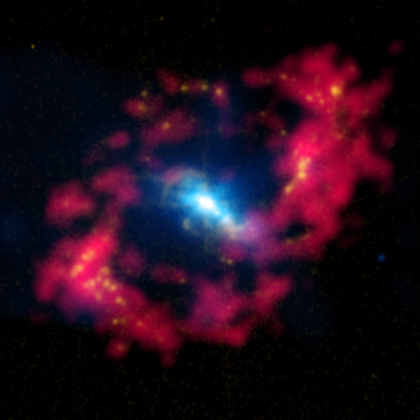
This composite image shows the central region of the spiral galaxy NGC 4151, dubbed the "Eye of Sauron" by astronomers for its similarity to the eye of the malevolent character in "The Lord of the Rings". In the "pupil" of the eye, X-rays (blue) from the Chandra X-ray Observatory are combined with optical data (yellow) showing positively charged hydrogen ("H II") from observations with the 1-meter Jacobus Kapteyn Telescope on La Palma. The red around the pupil shows neutral hydrogen detected by radio observations with the NSF's Very Large Array. This neutral hydrogen is part of a structure near the center of NGC 4151 that has been distorted by gravitational interactions with the rest of the galaxy, and includes material falling towards the center of the galaxy. The yellow blobs around the red ellipse are regions where star formation has recently occurred.
Submitted by chandra on Tue, 2011-03-08 18:43
Submitted by chandra on Fri, 2011-03-04 15:37
Some of our regular blog readers might be familiar with a project called “From Earth to the Universe,” or FETTU for short. FETTU was originally cast as a project for the International Year of Astronomy in 2009, but also has grown beyond that single designation. In a nutshell, FETTU puts astronomical images in public spaces like parks, metro stations, and art centers – basically any place you might not expect to run into them.
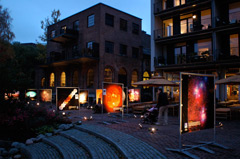
FETTU in downtown Oslo, Norway (Credit: H. Dahle)
Submitted by chandra on Thu, 2011-02-24 14:03
Lately, we’ve been noticing some great new videos that are covering some basic – yet hard-to-understand – concepts in astronomy. Here’s one we recently saw, featured on “Astronomy Picture of the Day,” that we thought was worth noting: http://apod.nasa.gov/apod/ap110222.html

Submitted by chandra on Wed, 2011-02-23 16:05
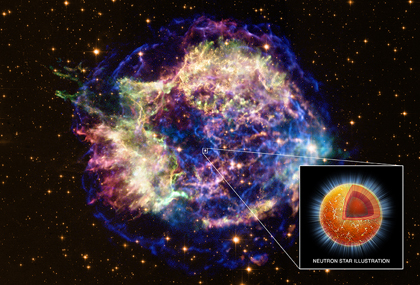
This composite image shows a beautiful X-ray and optical view of Cassiopeia A (Cas A), a supernova remnant located in our Galaxy about 11,000 light years away. These are the remains of a massive star that exploded about 330 years ago, as measured in Earth's time frame. X-rays from Chandra are shown in red, green and blue along with optical data from Hubble in gold.
Submitted by chandra on Tue, 2011-02-15 19:21
When I was a kid, my class was given ‘word problems’ for an alternative math lesson. You probably know the kind: two different trains traveling at different speeds, which one gets there first, etc. While these were possibly a little out of the norm, they didn’t quite excite the inner astronomer in me. Now, the folks at "Space Math @ NASA" have put together a comprehensive set of math activities for astrophiles of any age (or at least grades 3 and up).
Submitted by chandra on Wed, 2011-02-09 11:12
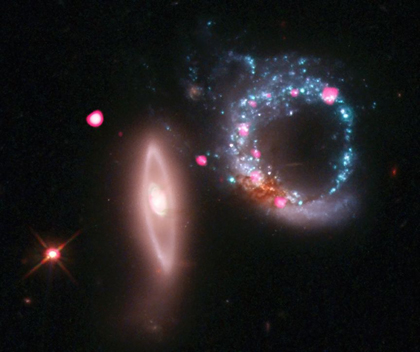
Just in time for Valentine's Day comes a new image of a ring -- not of jewels -- but of black holes. This composite image of Arp 147, a pair of interacting galaxies located about 430 million light years from Earth, shows X-rays from the NASA's Chandra X-ray Observatory (pink) and optical data from the Hubble Space Telescope (red, green, blue) produced by the Space Telescope Science Institute (STScI) in Baltimore, Md.
Arp 147 contains the remnant of a spiral galaxy (right) that collided with the elliptical galaxy on the left. This collision has produced an expanding wave of star formation that shows up as a blue ring containing in abundance of massive young stars. These stars race through their evolution in a few million years or less and explode as supernovas, leaving behind neutron stars and black holes.
Submitted by chandra on Thu, 2011-02-03 09:02
Every so often, our talented team gets to play with other colors in the crayon box -- that is, wavelengths outside the regime that Chandra observes. We do this for a number of reasons, not the least of which is that something great usually happens.
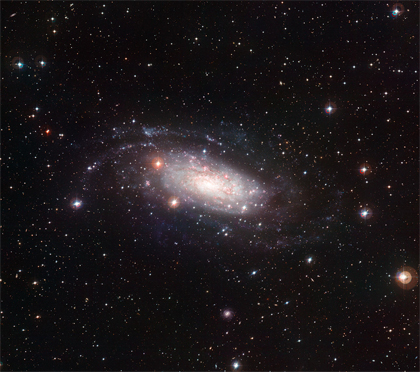
Pages